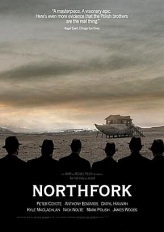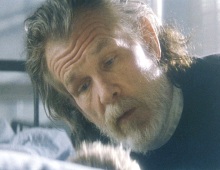|
Northfork
|
| |
 |
USA, 2003. Rated PG-13. 103 minutes.
Cast:
James Woods, Nick Nolte, Mark Polish, Duel Farnes, Mark Polish, Daryl
Hannah, Ben Foster, Anthony Edwards, Peter Coyote, Claire Forlani, Clark
Gregg, Kyle MacLachlan, Michele Hicks
Writers: Mark Polish and Michael Polish
Music: Stuart Matthewman
Cinematography: M. David Mullen
Producers: Hunt Lowry, Mark Polish, Michael Polish
Director: Michael Polish
LINKS
|
 t is quite fitting that Northfork was made by twin brothers (Mark and
Michael Polish). It exists on two planes—the real and the surreal, depending
on the viewer's notions of fantasy and reality. It explores the dual nature
of "progress." And ultimately, the viewer walks away with two, inexorable conclusions:
t is quite fitting that Northfork was made by twin brothers (Mark and
Michael Polish). It exists on two planes—the real and the surreal, depending
on the viewer's notions of fantasy and reality. It explores the dual nature
of "progress." And ultimately, the viewer walks away with two, inexorable conclusions:
- Northfork is a symbolic, visually delectable commentary on 1950s
Middle-American industrialization.
- Northfork is an exercise in monochromatic pretension.
Mark and Michael Polish's previous two features, Twin
Falls, Idaho and Jackpot, darkly probe into American heartland
niches. Twin Falls, Idaho documents the struggle of conjoined twins who
come to terms with mortality and separation, while Jackpot follows a
man on the karaoke contest circuit. With Northfork, Polish fans receive
a third installment that is nothing short of remarkable, but runs the risk of
alienating even non-mainstream audiences.
The film is set in 1955 Northfork, Montana, a town that is about to be submerged
by the waters of a new dam. With the dam, of course, will come power, lakefront
property, shopping centers, and other markers of American development. Most
of Northfork's citizens have departed with checks in hand, but a few remain
in protest and isolation.
A six-man, black-suited Evacuation team—led by father/son Walter and Willis
O'Brien (James Woods and Mark Polish)—is sent in pairs to remove the obstinate
few. They do it in the name of Growth (as evidenced by an oath they take before
each evacuation). They do it in the name of Greed (they are each promised 1.5
acres of the "new" land). They do it in identical, black Sedans.
Northfork's lingering residents include a man and his two wives who have fashioned
their house into an ark. The town Priest, Father Harlan (Nick Nolte) has also
stayed behind, as has a young, married couple, and an old man who camps out
on his porch shooting at whomever approaches his property.
In the midst of the evacuation lies a sickly orphan boy named Irwin (Duel Farnes).
Too ill to make the journey out of the desolate town, Irwin is labeled "defective"
by his adoptive parents, Mr. and Mrs. Hadfield (Clark Gregg and Claire Forlani),
and is returned unconscious to Father Harlan's care in the town Parish.
Northfork's narrative alternates between the Evacuators' struggle against
rural resistance and Irwin's adventures in an illness/sadness-induced dream
world. Here, Irwin is an angel whose wings have been amputated at birth. He
summons a surrogate family of fellow angels, Flower Hercules (Daryl Hannah)—an
androgynous parent; Cod (Ben Foster)—a young, mute cowboy; Happy (Anthony
Edwards)—a nearly blind scholar/surgeon with porcelain hands; and Cup of
Tea (Robin Sachs)—who is the embodiment of snobbery and cynicism. Yearning
to be accepted as "one of them," Irwin repeatedly tries to prove his angelic
authenticity.
Once viewers grow accustomed to shifting between dream and reality every five
minutes, they are entranced (or if they are not up for analyzing film, confused
and bored). The Polish brothers reinforce this haze by three techniques. The
first is the film's many allegorical references (the ark, the journey, the angels,
the wings, the priest, the blessed child). Secondly, obvious social symbolism
is employed. Industry is read as emotionless evil; its victims as simple-minded,
canonical, or insane.
Most effective in conveying Northfork's otherworldliness is its stunning
mise-en-scene and cinematography. The Polish brothers insisted on every visual
element falling within a ten-tone gray scale. Consequently, the film almost
looks as if it were shot in black and white. Initially, the eye laments Northfork's
lack of color. As with the narrative, however, the viewer acclimates to this
alternative climate, and elements like light, darkness, angle, and focus begin
to play a more prominent role. The city of Northfork is perceived more like
what it is—an arid ghost town. The Evacuators are visually read not as
men, but standardized machine parts, marching in black, suit-clad unison. Likewise,
Flower Hercules and her comrades in the angel world are bathed in light from
broken windows, which fits well with their ethereal personae.
M. David Mullen's cinematography is near flawless and tells Northfork's
story more effectively than the script. The viewer is taken literally into Irwin's
perspective—the swirling shot from a swing outside the angels' house serves
as a perfect precursor for his journey into magic realism. A shot of Father
Harlan speaking to the remnants of his congregation in front of a barren landscape
and a cross mirrors the shot of the Head Evacuator speaking to his team in front
of a chalkboard and an American flag. Mullen plays with humor via symmetrical
shots in the Northfork ark, placing (by perspective) mounted deer antlers over
the film's "Noah." He pits man against machine in the interior shots of Evacuator
Headquarters.
If it were not for the visual integrity of the film, Northfork would
be a sparse mess. The performances are intentionally subdued, with the exception
of Cup of Tea and Happy, and the dialogue exists more as clever quips. Cup of
Tea exclaims how he wishes he were Earl Grey, and Mr. O'Brien, standing in the
ark, identifies with his targets by saying, "We are all in the same boat."
Northfork will be a delight to film connoisseurs and theorists, as it
is rich in meaning, heavily coded, and photographed beautifully. It will appeal
to cultural historians, as it is frozen at that moment just before "the societal
dam" breaks—on the verge of resignation, near stagnancy.
For the average filmgoer, however, Northfork will be a sad and slow-paced
enigma, peppered with hollow characters. The fact that they are symbols of resistance,
change and longing will evoke a big, fat, "Who cares?"
"It is what we do with our wings that separates us," says the film's wisest
character, Father Harlan. With Northfork, the Brothers Polish clearly
choose to fly brilliantly and high on universal concepts, while spitting on
universal appeal.
Review
© August 2003 by AboutFilm.Com and the author.
Images © 2003 Paramount Pictures. All Rights Reserved.


